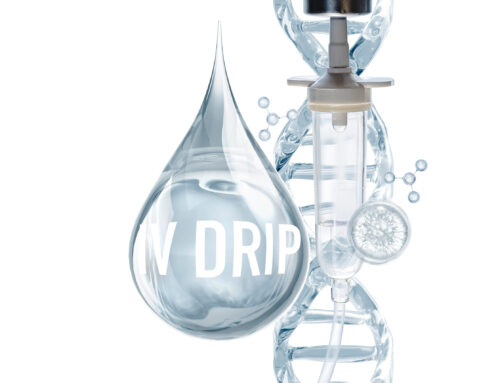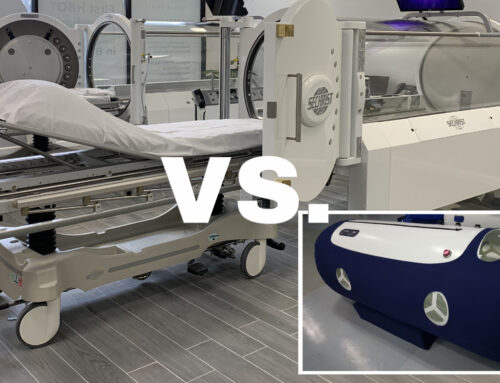Introduction
The onset of the post-COVID-19 condition, also known as “long COVID,” has become a significant topic among the medical community worldwide and has become a challenge to healthcare services everywhere.
This complex syndrome has impacted many people who have recovered from the acute phase of the SARS-CoV-2 infection. However, the chronic symptoms of COVID-19 can persist for months or even years after the acute phase.
HBOT’s Role in Long COVID
Hyperbaric oxygen therapy (HBOT) is one of the therapeutic interventions being studied for relieving symptoms. It marks a considerable step toward the recognition of the intertwined nature of the pathophysiology of post-COVID symptoms and the therapy offered.
The post-COVID condition covers a wide range of symptoms, including:
- Chronic fatigue syndrome
- Cognitive impairment, or “brain fog”
- Sleep problems
- Dyspnea
- Muscle pain
- Headache
- Anxiety
- Depression
- Neurological complaints
The differing symptoms imply that many bodily systems are involved. Researchers are investigating conditions like dysfunctional nerve cells, chronic inflammation, tissue hypoxia, and neuroinflammation. These drivers primarily support the pathophysiology of long COVID-19.
Pathophysiological Rationale for HBOT
HBOT relies on elucidating the phenomena that cause symptoms to persist after the acute phase of the disease for post-COVID recovery. The infection of SARS-CoV-2 may cause significant injuries to the cardiovascular and respiratory systems, thus impairing oxygen delivery and its use at the cellular level.
The virus’s attraction to the ACE2 receptors, mainly in endothelial cells, results in endotheliopathy, which occurs even after the virus disappears.
How HBOT Supports Better Help
HBOT uses pure oxygen at a pressure higher than the atmospheric pressure, usually within the range of 1.4-3.0 ATA (atmospheres absolute). Such a hyperbaric environment dramatically increases the amount of oxygen dissolved in plasma; thus, oxygen can reach even poorly perfused areas due to microcirculation damage.
Moreover, increasing the partial pressure of oxygen improves cellular metabolism, stimulates angiogenesis, provides energy for stem cell proliferation, and reduces inflammation.
Common symptoms in post-COVID patients, such as cognitive difficulties and fatigue, may be due to hypoxic brain injury and neuroinflammation. Studies show that HBOT facilitates brain plasticity, improves mitochondrial function, and inhibits neuroinflammation. Therefore, it provides a logical approach to treating these neurological conditions.
Clinical Evidence and Research Findings
Some acute clinical research has provided proof of concept in post-COVID condition therapy. A groundbreaking randomized controlled trial, published in Scientific Reports, proved that cognitive, psychiatric, fatigue, sleep, and pain symptoms of long-term COVID-19 patients were significantly reduced after HBOT treatment.
The assessment protocol used in the study included such diverse aspects as neurocognitive testing, quality of life measures, and functional capacity evaluations.
Clinical Treatment Courses Using HBOT
The therapeutic regimen most often associated with these studies includes sessions of 90 to 105 minutes, breathing 100% oxygen at a pressure of 2.0 to 2.4 ATA. Most of these studies have employed treatment courses ranging from 20 to 40 sessions, usually given daily or on alternate days for several weeks. Of course, parameters can differ depending on the patient’s characteristics and institutional rules.
A prospective registry study involving 232 patients provided valuable real-world evidence for HBOT’s effectiveness in long COVID. The three-month follow-up results showed sustained improvements across multiple symptom domains, with patients reporting enhanced quality of life, reduced fatigue levels, and improved cognitive function. Notably, the benefits were durable, persisting beyond the completion of treatment.
Lasting Relief
Long-term outcome data from randomized controlled trials have further supported HBOT’s sustained efficacy. Follow-up studies have documented that improvements in neurocognitive functions, fatigue scores, and overall functional capacity are maintained for extended periods following treatment completion. This durability suggests HBOT may induce fundamental physiological changes rather than provide temporary symptomatic relief.
A systematic review examining the effects of HBOT on long-term COVID-19 concluded that the therapy demonstrates significant potential for improving the diverse symptoms associated with post-COVID-19 conditions. The review highlighted the consistency of positive outcomes across different study designs and patient populations. At the same time, it acknowledged the need for larger, well-designed randomized controlled trials to establish definitive treatment guidelines.
Mechanisms of Action that Show HBOT Efficiency
Therapeutic mechanisms underlying HBOT efficiency in post-COVID are multifarious and interrelated.
Improved Mitochondrial Function
The hyperoxic condition formed by HBOT in the cell enhances mitochondrial function, which is often impaired in post-COVID patients. Mitochondrial dysfunction is one of the factors responsible for persistent fatigue and exercise intolerance observed in long COVID; thus, restoring optimal cellular energy production becomes a critical therapeutic target.
Anti-inflammatory Support
Plus, HBOT’s anti-inflammatory action is carried out via a few processes, such as regulating cytokine synthesis and decreasing oxidative stress. Chronic inflammation is an identifying feature of the post-COVID condition. Therefore, HBOT’s capability to reduce inflammatory mediators while promoting tissue repair makes it very suitable for this syndrome.
Endothelial Cell Regrowth
Moreover, the effect of therapy on endothelial function is an additional important mechanism. HBOT supports endothelial cell regrowth, makes nitric oxide more bioavailable, and improves microcirculatory function. Endothelial dysfunction is at the core of many post-COVID symptoms..
Neuroplasticity
Neuroplasticity is another good reason HBOT patients experience post-therapy for COVID. The therapy has been proven to induce the synthesis of neurotrophic factors, the growth of nerve connections, and support white matter integrity. These factors might be most relevant to resolving the cognitive impairment and neurological symptoms that comprise the main challenges of long COVID.
Treating Long COVID Using HBOT
HBOT protocols for post-COVID patients typically involve treatment pressures ranging from 2.0 to 2.4 ATA, with session durations of 90 to 105 minutes. The treatment schedule usually consists of five weekly sessions, resulting in 20 to 40 treatments. Some protocols incorporate air breaks during each session to minimize the risk of oxygen toxicity and enhance patient comfort.
Profiles of Post-COVID-19 Patients Who Use HBOT
Patient selection criteria are essential considerations for optimizing treatment outcomes. Candidates for HBOT should have a confirmed history of COVID-19 infection with persistent symptoms lasting more than 12 weeks. Comprehensive pre-treatment evaluation should include assessment of symptom severity, functional capacity, and exclusion of absolute contraindications to hyperbaric exposure.
Contraindications
Contraindications to HBOT include untreated pneumothorax, severe chronic obstructive pulmonary disease with CO2 retention, and certain medications that may interact adversely with hyperbaric oxygen. Relative contraindications require careful evaluation and may include severe anxiety, claustrophobia, and inability to equalize middle ear pressure.
Safety Profile and Adverse Effects
The safety profile of HBOT is generally permissible under established protocols and proper patient examination. The most common side effects are of minor severity, such as ear discomfort associated with pressure changes and transient changes in vision. A bit of fatigue may alter treatment sessions. Serious side effects like barotrauma, oxygbarotrauma, and fire-related problems in an oxygen-rich environment are, however, very infrequent.
Middle Ear Barotrauma
Middle ear barotrauma is the most frequently reported complication, occurring when patients are unable to adequately equalize pressure during compression and decompression phases. It can be minimized through proper patient education, pre-treatment evaluation of eustachian tube function, and careful pressure management during treatments.
Future Directions and Research Needs
Though present data supports HBOT’s efficiency in post-COVID recovery, a few issues still need further research. Controlled trials with more extended follow-up periods are required to establish an optimal treatment regimen and identify markers of treatment response. Investigation into the molecular mechanisms that are at the basis of HBOT’s effects in post-COVID patients may result in additional therapeutic targets and lend direction to protocol optimization.
Introducing biomarkers in the treatment process to monitor progress and predict results would be very helpful to clinicians when making decisions to execute personalized therapy. Furthermore, studies that investigate the cost-effectiveness of HBOT in contrast to other possible interventions for post-COVID conditions are highly needed to determine health care policy.
Exploration of other directions in the future may include co-administration of HBOT with some other evidence-based intervention, such as exercise rehabilitation, cognitive behavioral therapy, or pharmacological treatments. Thus, the benefits can multiply, and it is expected that the improvements for patients with complex post-COVID presentations will become even better.
Conclusion
HBOT stands as a bright hope for post-COVID recovery, with its growing evidence of efficacy across different symptom domains. The therapy that can handle most issues of post-COVID condition, pathophysiologically speaking, including tissue hypoxia, endothelial dysfunction, neuroinflammation, and mitochondrial impairment, justifies the use of is a treatment option for this complicated syndrome.
The current clinical studies indicate significant improvement in cognitive functions, fatigue, sleep quality, and overall life quality after the therapy of HBOT, with the benefit sustained over time. The safety profile and the long-lasting nature of treatment benefits are two essential points making HBOT an attractive choice for patients who experience constant symptoms of post-COVID.
As research on the post-COVID condition unravels, HBOT may become a backbone therapy in the comprehensive management of this challenging condition. Continuous research will be conducted to optimize treatments, identify the patients best suited for them, and establish HBOT’s place among the various therapies available in post-COVID care.
______________________________________________________________________
1659 Ralph Ave., Brooklyn, NY 11236
phone 718-255-9955
fax 718-228-3772
________________________________________________________________________
References
- Zilberman-Itskovich, S., et al. (2024). Long-term outcomes of hyperbaric oxygen therapy in post-COVID condition: longitudinal follow-up of a randomized controlled trial. Scientific Reports, 14, 3456. Available at: https://www.nature.com/articles/s41598-024-53091-3
- van Campen, C., et al. (2024). Hyperbaric Oxygen Therapy for Long COVID: 3-Month Follow-up Results from a Prospective Registry of 232 patients. medRxiv. Available at: https://www.medrxiv.org/content/10.1101/2024.09.02.24312948v1
- Hadanny, A., et al. (2024). Hyperbaric oxygen effectively addresses the pathophysiology of long COVID: clinical review. Frontiers in Medicine, 11, 1354088. Available at: https://www.frontiersin.org/journals/medicine/articles/10.3389/fmed.2024.1354088/full
- Zilberman-Itskovich, S., et al. (2022). Hyperbaric oxygen therapy improves neurocognitive functions and symptoms of post-COVID condition: randomized controlled trial. Scientific Reports, 12, 11252. Available at: https://www.nature.com/articles/s41598-022-15565-0






